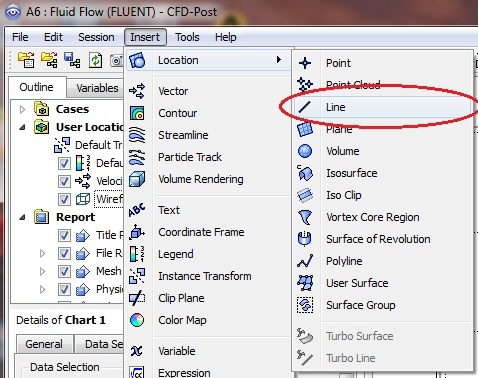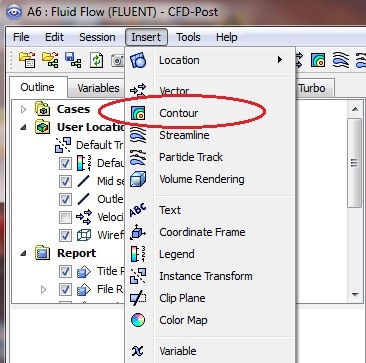Author: John Singleton and Rajesh Bhaskaran, Cornell University
Problem Specification
1. Pre-Analysis & Start-up
2. Geometry
3. Mesh
4. Setup (Physics)
5. Solution
6. Results
7. Verification & Validation
Exercises
Post Processing
We will use CFD-Post as the primary post processing GUI. Steps for post processing in FLUENT can be found here.
Step 6. Results
Double click on Results from the Workbench Window to launch CFD-Post.
Velocity Vectors
Click on the z-axis, to view the XY plane. Click on the vector icon to insert a vector plot. Name it Velocity Vector.
A panel named "Details of Velocity Vector" will appear right below the outline window. Set the Locations to symmetry 1. Click on Apply to display the velocity vectors.
The velocity vectors will be displayed in the view window.
You can use the wheel button of the mouse to zoom into the region that closely surrounds the plate, to get a better view of the boundary layer velocities:
Outlet Velocity Profile
From the menu, insert > location > line. Name it "Outlet"
In the Details of Outlet panel, enter the following coordinates. Change the number of samples to 50. Click on Apply to create a line at the outlet.
Insert a chart from the menu: insert > chart. Name the chart "Outlet Velocity Profile". Change the title to "Velocity Profile" in the General tab. In the Data Series tab, rename Series 1 to FLUENT and select Outlet for location. Select Velocity as the variable in the X Axis tab and select Y as the variable in the Y Axis tab. Click on Apply to generate the chart.
The velocity profile at the outlet is shown below:
We would like to compare the FLUENT result to the Blasius boundary layer solution. Download the Blasius solution here. Return to the Data Series tab and insert another data set. Rename it Blasius. Instead of specifying the location of the data, select the Blasius solution file you have downloaded.
Click on Apply. The comparison should look like the following plot:
Mid-Section Velocity Profile
Here, we will plot the variation of the x component of the velocity along a vertical line in the middle of the geometry. In order to create the profile, we must first create a vertical line at x=0.5m. Insert another line, same as the previous step, and name it Mid section. Enter the following numbers to create a vertical line at x=0.5m. Set the number of samples to 50. Remember to click on Apply to finish.
Insert another chart and name it Mid Section Velocity Profile. In the General tab, change the title to "Velocity profile". Select Mid Section as the location and rename Series 1 to Mid section. We will compare the velocity profiles at the mid section and at the outlet. Repeat the procedure in the previous step to insert the velocity profile at the outlet. Change the variable to Velocity in the X Axis tab and change the variable to Y in the Y Axis tab. Click on Apply to generate the chart.
The velocity profile comparison is shown below:
Pressure Contour
Insert > Contour. Name it Pressure contour.
In Details of Pressure contour, change the locations to symmetry 1, change the variable to Pressure, and change the number of contours to 50.
Click on Apply to view the contour.
Skin Friction Coefficient
In FLUENT post processor the skin friction coefficient can be plotted as a function of distance along the plate. In CFD post, we can find the skin friction coefficient at each point along the axis. To create a point, click on Insert > Location > Point. Name it wall point.
In details of Point, retain the default XYZ value, (0,0,0), and click on Apply.
A point will be created at the coordinate (0,0,0), which is at the lower left corner of the solution domain.
In the expression tab, create a new expression by right click in the expression window and select "new". Name it Wall shear.
In Details of Wall shear, enter the following definition and click on Apply. The value for the wall shear stress will be displayed.
We will now define the dynamic pressure. Create another expression and name it Dynamic pressure. In Details of Dynamic pressure, enter the definition below and click on Apply.
It is important to enter the appropriate units so the dynamic pressure has the correct unit. Recall both the density and the upstream velocity are set to 1.
The skin friction coefficient is the wall shear stress divided by the dynamic pressure. Create another expression and name it Cf. Enter the following and click on Apply.
The skin friction coefficient is a dimensionless parameter. The value is 0.129533 at the point (0,0,0). The value at a different location on the wall can be found by simply changing the x coordinate of the point you defined earlier. The wall shear will be computed at the new location and a new value of skin friction coefficient will be updated. For instance, the skin friction coefficient at the center of the plate (0.5,0,0) is 0.0114268.
Important!
You MUST click on Apply whenever you update the coordinates of the point. Same with the skin friction coefficient, you MUST click on Apply to update the value.
The skin friction coefficient along the plate is shown below:
It is of interest to compare the numerical skin friction coefficient profile to the skin friction coefficient profile obtained from the Blasius solutionWe will compare the FLUENT result to the Blasius solution. Download the Blasius solution here. The comparison is shown below:
Go to Step 7: Verification & Validation
 Sign-up for free online course on ANSYS simulations!
Sign-up for free online course on ANSYS simulations!


